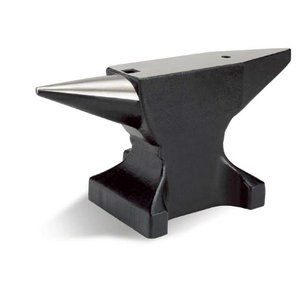The Best Way To Use An Anvil
Metalworking is an impressive skill set. Blacksmiths work at perfecting their craft for years before they feel masterful. Some of the most successful blacksmiths in the United States have workshops where they own and operate their custom metal fabrication business. They often use an anvil for metal forging to create some pretty amazing things.
The Anatomy Of An Anvil
Anvils come in a variety of shapes and sizes. The shape is much more than how the anvil looks; it also allows you to bend, shape, and cut the metal. This Rigid 165-lb forged anvil will be our guide for this demonstration.

- The Horn: The horn allows you to effectively curve heated metal using a variety of diameters, ensuring the perfect curve.
- The Hardie Hole: The giant hole, usually a big square hole in the body of the anvil, is called a hardie hole. This hole lets you put tools directly on the anvil to improve its functionality. For example, you could insert a metal bending tool into the Hardie hole and bend metal without leaving the anvil.
- The Face: The face is the surface of the anvil on which you put your metal to strike.
- The Pritchel Hole: The small, round hole in the body of the anvil is called the pritchel hole. This hole allows you to pierce holes into the metal you’re working with using a punch.
- The Heel: The heel of the anvil is the end opposite the horn. This sharper area is generally used for sharp bends in metal.
- The Body: The body is the thick part of the anvil.
- The Waist: The waist is the narrow part below the body and above the base.
- The Base: The base of the anvil is between the narrow waist and the feet.
- The Foot: The foot of the anvil is, as the name suggests, what the anvil rests on.
Some anvils have a cutting area at the base of the horn. This is your cutting surface. Never cut on the face of the anvil. Always use the base of the horn as your cutting board.
Anvil Sizes
The type of anvil you use will significantly depend on what you need it for. Here is a list of a variety of anvils and a brief description of each:
- Jeweler’s Anvil—This particular anvil is exceptionally lightweight because jewelers work with lightweight metals and gemstones. It weighs only about one-half to five pounds, and its body is much the same as its larger counterparts.
- Bench Anvil—These lightweight anvils may weigh between five and 50 pounds. They’re small and generally used on a bench or a workshop table.
- Farrier’s Anvils—This anvil is designed explicitly for farriers, metalworkers who make horseshoes. It is similar to other types of anvils in shape, but it weighs roughly 100 to 150 pounds.
- Forging Anvils are the most common type of anvil. These are the anvils you would typically use if working metal today. They range in weight from 75 pounds to 500 pounds or more.
Tapping The Anvil
Many people ask why a metalworker taps the anvil with the hammer between strikes to the metal. Some people speculate it is a way to keep the hammer from getting too hot, but that isn’t the case. We want the hammer and the anvil face to be hot so the metal doesn’t cool as quickly. It’s simply a way to keep the rhythm going or to get a better grip on the hammer between strikes. Tapping also makes the hammer jump back up quickly to reduce strain on the metalworker’s arm.




